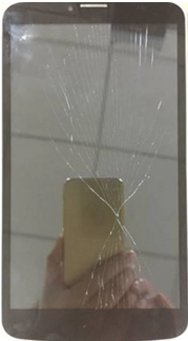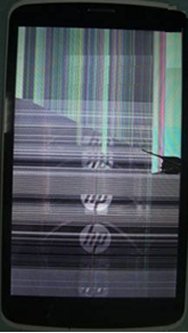This document pertains to HP Tablets with LCD display screens.
HP Tablets - Diagnosing a Liquid Crystal Display (LCD) for Damage
This document explains how to diagnose an LCD for damage and what to do once you have diagnosed it.
LCD display screens on tablets are made of two thin layers of glass with dark liquid crystal material in between. The glass is covered on the outside by a layer of plastic. Customers often feel there cannot be a broken LCD display because they cannot feel the break. However, cracks in the glass usually cannot be felt because the plastic covering rarely breaks or fractures.
When the LCD display glass is broken, any of the following might happen:
-
Lines or patterns might appear on the screen. There might be many lines or only a few lines.
-
Black “spots” might also appear. This can be liquid crystal material spilling out of a crack. A crack might be present which causes lines to appear but no liquid crystal spots are apparent. The spots might be small or might appear later or grow larger in time. Customers often say that there were no black spot(s) when the unit was sent for repair, so it must have occurred during or after shipment.
-
The screen might be totally black; however, some sort of pattern can usually be seen if you look closely.
It is important to understand that lines on the LCD can also be caused by video driver issues or a problem with the media you are using. Video driver issues can normally be resolved by downloading and installing a new video driver. However, if the damage is due to a broken LCD, you should understand the following policies.
Accidental Damage Protection (ADP)
HP provides its customers the option to purchase an Accidental Damage Protection (ADP) plan. This plan must be purchased prior to any damage occurring. Customers may purchase the ADP plan through the retailer where they purchased the computer.
Customer Induced Damage to an LCD screen (CID)
Customer Induced Damage is not covered under standard warranty. Most damaged or broken LCDs will be considered as CID.
Occasionally there are exceptions. Therefore, you might want to contact a service agent for additional information. Also, for customers who receive their units from service with damage, the repair will be set up as an exception.
Examples of Customer Induced Damage to an LCD screen (CID)
The following table shows examples of damaged panels and common descriptions for the damage.
All of these examples are of damaged panels that would not be covered by standard warranty.
|
CID Defect
|
Description
|
Example of damaged LCD Panel
|
|
Black splotches cutting through the screen
|
The internal glass has cracked and liquid crystal is leaking (sometimes called bleeding) inside the display panel along the crack.
|

|
|
Broken glass
|
The broken glass might be visible, as well as black and white blotches.
|

|
|
Diagonal or jagged lines and/or the presence of both horizontal and vertical lines
|
Diagonal or jagged lines and both horizontal and vertical lines indicate panel damage. One set of either horizontal or vertical lines might be a damaged panel, but can also be caused by graphics system failure or a loose internal video cable.
|

|
The damage to my LCD screen is not covered by standard warranty. What can I do now?
In most cases, this damage is considered customer induced and is not covered by any standard warranty. Therefore, it will be the owner's responsibility to cover the cost of repair unless they have previously purchased Accidental Damage Protection (ADP). If the computer is out of warranty, a fee-based service may be initiated by contacting HP.
Εισαγάγετε ένα θέμα για αναζήτηση στη γνωσιακή βιβλιοθήκη μας
Πώς μπορούμε να σας βοηθήσουμε;
Χρειάζεστε βοήθεια;
